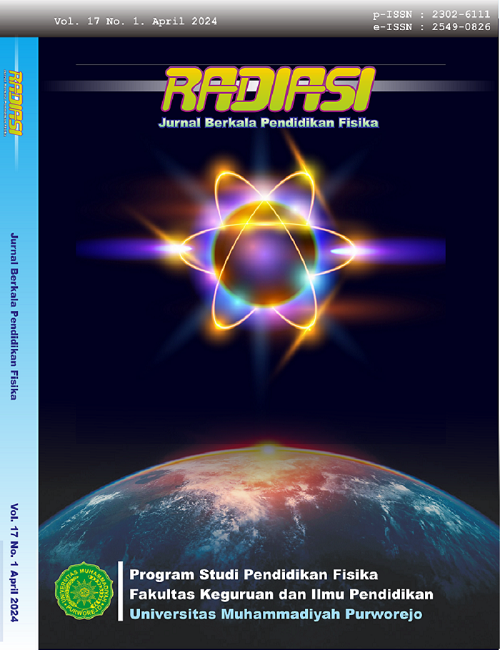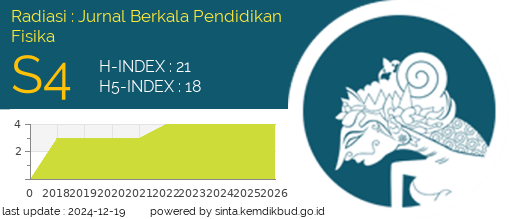Profile of Celestial Object Identification Skills of Junior High School Students in Indonesia
Abstract
The ability to identify celestial objects provides significant benefits for improving students' motivation, understanding of the subject matter, reasoning, and skills, yet this area remains underexplored by researchers. This study aims to describe the profile of junior high school students' ability to identify celestial objects in science learning, particularly in the Solar System topic, focusing on their experiences in recognizing the names of celestial objects at night. Using a qualitative approach, this research involved semi-structured interviews with three science teachers and a survey of 31 7th-grade students who had not been taught the Solar System topic. The research instruments included student characteristics, availability of learning resources, challenges faced by students, teaching methods, and responses to the idea of outdoor learning with the assistance of an Augmented Reality (AR) application. The results indicate that, generally, students are not yet able to identify celestial objects other than the Moon due to limited prior experience and knowledge. Although teachers have attempted to introduce identification methods through instructional videos and direct explanations, this method is considered less accurate due to discrepancies between classroom learning and field experiences. However, both teachers and students recognize that identifying celestial objects can enrich understanding of the subject matter, increase motivation, and stimulate gratitude for God's creation. The positive response to the idea of outdoor learning with an AR application indicates high interest from both teachers and students in this approach.
Downloads
References
J. Plummer, “Early elementary students’ development of astronomy concepts in the planetarium,” J. Res. Sci. Teach., vol. 46, no. 2, pp. 192–209, 2009, doi: 10.1002/tea.20280.
J. Trefil and R. M. Hazen, The sciences: An integrated approach. John Wiley & Sons, 2016.
J. R. McGinnis and D. Roberts-Harris, “A new vision for teaching science,” Sci. Am. Mind, vol. 20, no. 5, pp. 62–67, 2009.
J. D. Plummer, “Spatial thinking as the dimension of progress in an astronomy learning progression,” Stud. Sci. Educ., vol. 50, no. 1, Art. no. 1, 2014.
C. Niederriter and M. Belloni, “Astrophotography on the cheap,” Phys. Teach., vol. 50, no. 9, pp. 520–522, 2012.
D. L. Moché, Astronomy: A Self-Teaching Guide, Eighth. Trade Paper Press, 2014.
E. Calderón-Canales, F. Flores-Camacho, and L. Gallegos-Cázares, “Elementary students’ mental models of the solar system,” Astron. Educ. Rev., vol. 12, no. 1, p. 010108, 2013.
F. Korur, “Exploring seventh-grade students’ and pre-service science teachers’ misconceptions in astronomical concepts,” Eurasia J. Math. Sci. Technol. Educ., vol. 11, no. 5, pp. 1041–1060, 2015.
R. Trumper, “A cross-age study of junior high school students’ conceptions of basic astronomy concepts,” Int. J. Sci. Educ., vol. 23, no. 11, pp. 1111–1123, 2001.
S. Abell, M. Martini, and M. George, “‘That’s what scientists have to do’: preservice elementary teachers’ conceptions of the nature of science during a moon investigation,” Int. J. Sci. Educ., vol. 23, no. 11, pp. 1095–1109, 2001.
D. Ç. Aktan and E. O. Dinçer, “examination of pre-service science teachers’ understanding levels of kepler’s laws with ranking task questions,” J. Balt. Sci. Educ., vol. 13, no. 2, p. 276, 2014.
E. E. Çevik, H. BOZDEMİR, S. C. Helvaci, and M. A. Kurnaz, “The opinions of prospective science teachers about some basic astronomy concepts,” Cukurova Univ. Fac. Educ. J., vol. 49, no. 2, pp. 1025–1060, 2020.
N. M. Pujani and N. K. Rapi, “Pelatihan Praktikum IPBA Bagi Guru SMP/SMA di Kota Singaraja Menuju Olimpiade Astronomi,” Widya Laksana, vol. 2, no. 1, pp. 20–30, 2017.
J. Zhang, Y.-T. Sung, H.-T. Hou, and K.-E. Chang, “The development and evaluation of an augmented reality-based armillary sphere for astronomical observation instruction,” Comput. Educ., vol. 73, pp. 178–188, 2014, doi: https://doi.org/10.1016/j.compedu.2014.01.003.
D. Duncan and L. Arthurs, “Improving student attitudes about learning science and student scientific reasoning skills,” 2012.
M. Cole, C. Cohen, J. Wilhelm, and R. Lindell, “Spatial thinking in astronomy education research,” Phys. Rev. Phys. Educ. Res., vol. 14, no. 1, p. 010139, 2018.
Ö. Oktay, S. Ekinci, and A. İ. Şen, “Investigation of middle school students’ thoughts about a mobile planetarium activity,” Elem. Educ. Online, vol. 19, no. 2, Art. no. 2, 2020, doi: https://doi.org/10.17051/ilkonline.2020.693202.
J. A. Utama, “Astronomi yang (Sudah) Membumi: Sejak Masa Nusantara hingga Abad Terkini1,” in Prosiding Seminar Nasional Fisika (SNF), 2018, pp. iv–xii.
C.-L. Chiang, Y.-L. Lin, H.-C. Chao, J.-Y. Chen, and C.-H. Lai, “Effect of Augmented Reality on Astronomical Observation Instruction,” in International Conference on Innovative Technologies and Learning, Springer, 2019, pp. 184–193. doi: https://doi.org/10.1007/978-3-030-35343-8_20.
M. Najib, A. Syawaluddin, and S. Raihan, “Pengembangan multimedia pembelajaran interaktif sistem tata surya berbasis literasi sains untuk siswa SD,” J. Inov. Pedagog. Dan Teknol., vol. 1, no. 1, pp. 1–13, 2023.
P. B. Marsa and D. Desnita, “Analisis Media, Sumber Belajar, dan Bahan Ajar Yang Digunakan Guru Fisika SMA Materi Gelombang Di Sumatera Barat Ditinjau Dari Kebutuhan Belajar Abad 21,” J. Eksakta Pendidik. Jep, vol. 4, no. 1, pp. 81–88, 2020.
E. N. Qorimah, W. C. Laksono, Y. M. Hidayati, and A. Desstya, “Kebutuhan Pengembangan Media Pembelajaran Berbasis Augmented Reality (AR) pada Materi Rantai Makanan,” J. Pedagogi Dan Pembelajaran, vol. 5, no. 1, Art. no. 1, Apr. 2022, doi: 10.23887/jp2.v5i1.46290.
W. Liliawati, T. R. Ramalis, and C. P. Asmoro, “Efektifitas pelatihan penggunaan teleskop di sekolah untuk guru-guru IPA di Kabupaten Bandung Barat,” in Seminar Nasional Fisika, 2019, pp. 234–237.
S. V. Artinta and H. N. Fauziah, “Faktor yang mempengaruhi rasa ingin tahu dan kemampuan memecahkan masalah siswa pada mata pelajaran ipa smp,” J. Tadris IPA Indones., vol. 1, no. 2, pp. 210–218, 2021.
D. K. Fitra, “Pembelajaran Berdiferensiasi dalam Perspektif Progresivisme pada Mata Pelajaran Ipa,” J. Filsafat Indones., vol. 5, no. 3, pp. 250–258, 2022.
S. A. Kiray, B. Gok, and A. S. Bozkir, “Identifying the Factors Affecting Science and Mathematics Achievement Using Data Mining Methods,” J. Educ. Sci. Environ. Health, vol. 1, no. 1, p. 28, Jan. 2015, doi: 10.21891/jeseh.41216.
S. O. Oyedeji, “Mathematics skills as predictors of science achievement in junior secondary schools,” World J. Young Res., vol. 1, no. 4, pp. 60–65, 2011.
S. Supeno, D. K. Fitriani, D. Wahyuni, and R. Rahayuningsih, “Pengembangan Media Interaktif Berbasis Articulate Storyline Pada Pembelajaran Ipa Materi Sistem Tata Surya Untuk Meningkatkan Literasi Sains,” J. Eduscience, vol. 9, no. 2, pp. 294–304, 2022.
A. G. Putri, N. N. Ganing, and M. G. R. Kristiantari, “Video Animasi Materi Sistem Tata Surya Berorientasi Problem Based Learning dalam Pembelajaran di Sekolah Dasar,” J. Lesson Learn. Stud., vol. 5, no. 1, pp. 106–116, 2022.
K. Kazwaini, M. Nazir, P. Promadi, and D. C. Sari, “Nilai Keislaman pada Buku Ajar IPA SMP/MTs untuk Pembentukan Karater Religius Siswa,” J. Nat. Sci. Integr., vol. 4, no. 2, pp. 277–295, 2021.
A. N. Nurfadilah, A. Julia, R. Trisnawati, W. N. Fitriani, and H. Fajrussalam, “Pembelajaran IPA SD Menurut Perspektif Islam,” Ikhtisar J. Pengetah. Islam, vol. 2, no. 1, pp. 34–46, 2022.
A. D. Purwanti, “Penerapan pendekatan kontekstual untuk meningkatkan minat belajar siswa pada pembelajaran IPA di sekolah dasar,” J. Ilm. Guru Caraka Olah Pikir Edukatif, vol. 16, no. 2, 2012.
M. Amaliyah, I. N. Suardana, and K. Selamet, “ANALISIS KESULITAN BELAJAR DAN FAKTOR-FAKTOR PENYEBAB KESULITAN BELAJAR IPA SISWA SMP NEGERI 4 SINGARAJA,” J. Pendidik. Dan Pembelajaran Sains Indones. JPPSI, vol. 4, no. 1, Art. no. 1, Apr. 2021, doi: 10.23887/jppsi.v4i1.33868.
R. Azizah, L. Yuliati, and E. Latifah, “Kesulitan pemecahan masalah fisika pada siswa SMA,” J. Penelit. Fis. Dan Apl. JPFA, vol. 5, no. 2, pp. 44–50, 2015.
M. Yusup, “Multirepresentasi dalam pembelajaran fisika,” in Prosiding Seminar Nasional Pendidikan FKIP Unsri, 2009, pp. 1–7.
A. Astalini, D. A. Kurniawan, R. Perdana, and H. Pathoni, “Identifikasi sikap peserta didik terhadap mata pelajaran fisika di sekolah menengah atas negeri 5 Kota Jambi,” UPEJ Unnes Phys. Educ. J., vol. 8, no. 1, pp. 34–43, 2019.
A. Zahara, S. Feranie, and N. Winarno, “Influence of discovery learning supported by solar system scope application on students’ curiosity: The case of teaching solar system,” in Proceedings of the 7th Mathematics, Science, and Computer Science Education International Seminar, MSCEIS 2019, 12 October 2019, Bandung, West Java, Indonesia, 2020.
J.-P. Ayotte-Beaudet, P. Potvin, H. G. Lapierre, and M. Glackin, “Teaching and learning science outdoors in schools’ immediate surroundings at K-12 levels: A meta-synthesis,” EURASIA J. Math. Sci. Technol. Educ., vol. 13, no. 8, pp. 5343–5363, 2017.
I. Cercel and A. Iftene, “Planetarium-an augmented reality application,” in Proceedings of the Conference on Mathematical Foundations of Informatics MFOI2020,(Kyiv, Ukraine), 2021, pp. 62–77.
N. Fajriani and M. Masturi, “Utilization of Sky Map Application in Astronomy Learning of Celestial Coordinates to Improve Students’ Understanding of Concepts and Digital Literacy for Physics Education Students,” Berk. Ilm. Pendidik. Fis., vol. 11, no. 1, pp. 80–88, 2023.
A. Khusnani et al., “Pemanfaatan Aplikasi Stellarium dan Alat Peraga Astronomi NASE (Network for Astronomy School Education) sebagai Pembelajaran Etnoastronomi,” Surya Abdimas, vol. 6, no. 4, Art. no. 4, Oct. 2022, doi: 10.37729/abdimas.v6i4.2114.
N. Şahi̇N and B. Güler, “Astronomi Öğrenme Ortamlarını Zenginleştirmeye Yönelik Bir Uygulama: Star Walk 2,” Öğretim Teknol. Ve Hayat Boyu Öğrenme Derg. - Instr. Technol. Lifelong Learn., Dec. 2021, doi: 10.52911/itall.1026242.
Copyright (c) 2024 Dinar Maftukh Fajar, Mila Nindi Alfiatin Zahroh, Hamidatul Masfufah

This work is licensed under a Creative Commons Attribution-NonCommercial 4.0 International License.




